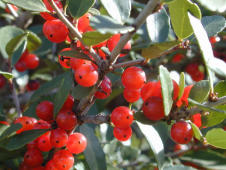|

Color planning in your fall garden
By Urban Harvest
 The fall and winter months are a challenge to provide color in the garden. Enjoying the grays, oranges, yellows and reds of fall color, as many plants change their colors and lose their leaves to prepare for winter, is what lots of folks look forward to, even here in Houston. The fall and winter months are a challenge to provide color in the garden. Enjoying the grays, oranges, yellows and reds of fall color, as many plants change their colors and lose their leaves to prepare for winter, is what lots of folks look forward to, even here in Houston.
There are several techniques one can use to help maintain color into the winter months. Naturally, there will not be as much color for the fall and winter garden as for the spring and summer garden, but with planning and special plants we can have a more colorful winter garden.
One technique is to use small evergreen shrubs or vines spaced strategically in the garden to provide not only green color but also contrast with the grays or other muted colors of plants in winter.
The Southern wax myrtle (Myrica cerifera) is an excellent plant for this purpose. This small tree or shrub-like tree is native to Texas and many of the eastern states. It is a great plant for any landscape for several reasons. It usually grows to between 15 and 25 feet tall or it is can be pruned and maintained as a shrub. It grows well in Houston's clay soil, grows nicely in the shade of taller trees or in full sun.
It makes an attractive addition to a yard and is a great substitute for ligustrum or red-tipped photinia which are now beginning to have disease problems. As an evergreen it provides a visual screen for privacy and provides shelter on cold, windy nights for birds. Additionally, the berries of female plants are consumed by many species of birds. The presence of birds in your yard will also add splashes of color.
The American goldfinch is another colorful visitor to many Houston yards during winter months. This colorful bird is easily attracted to a bird feeder with niger seeds or hulled, small sunflower seed. Natural food sources for this bird include plants that produce rather small seeds including various sunflowers, dandelion, thistles and goldenrod.
American Sweet gum (Liquidambar styraciflua) is a tree that provides splendid fall color with leaves ranging from brilliant yellows to scarlet reds. It produces seeds that are a natural food source for the American goldfinch. Some people are not fond of the seedpods in the yard but if you have a special spot for this beautiful tree, it is one well worth planting.
Sweet gum grows naturally in bottomlands and along bayous and does well throughout the upper Texas coastal area.
Two medium-sized shrubs that grow well, are attractive and add color to the landscape are Yaupon holly (Ilex vomitoria) and possumhaw or deciduous holly (Ilex decidua).
Each produces berries which ripen in the fall and winter. The deciduous holly will lose most to all it its leaves and is usually covered in orange to red berries, which is a beautiful contrast to the grayish bark. Yaupon holly is evergreen and has bright red berries. Robins, cedar waxwings, mockingbirds, cardinals and many other species of birds will eat these berries.
Another beneficial and attractive native holly is the American holly (Ilex opaca) a tree that grows to 60 feet tall. American holly is a stately and attractive ornamental tree that should be used in landscapes in our area more often.
Eastern red cedar (Juniperus virginiana) is another attractive evergreen tree that is attractive in a landscape. The cedar waxwing takes its name from its fondness of the cedar berries of the Eastern red cedar, which make up a significant portion of its diet. As an evergreen, it provides shelter from inclement weather for many species of birds. It grows well in our area reaching heights of up to 50 feet.
An attractive small shrub to be considered for the garden is the strawberrybush (Euonymus americanus). It prefers shade to dappled shade so fits in nicely as an under story plant beneath the live oaks that are in most yards. The bright red fruit which looks similar to a strawberry, is held until late fall. The small limbs and trunks are green, not gray, like most other trees! In December to January the leaves turn beautiful but soft shades of reds.
Blue mist flower (Conoclinium coelestinum or Eupatorium coelestinum) has an attractive, sky blue flower and grows 10 to 20 inches tall. It continues to bloom from late summer into December and January if we do not have freezing weather. It's an excellent plant for color in the winter garden, and butterflies love it too.
This column is produced by Urban Harvest. Learn about gardening classes, community gardens and orchards, farmers markets and more at www.urbanharvest.org. This article was written by Glenn Olsen who served as a past state president of the Native Plant Society of Texas and as vice president of Education of the Houston Audubon Society.
|
